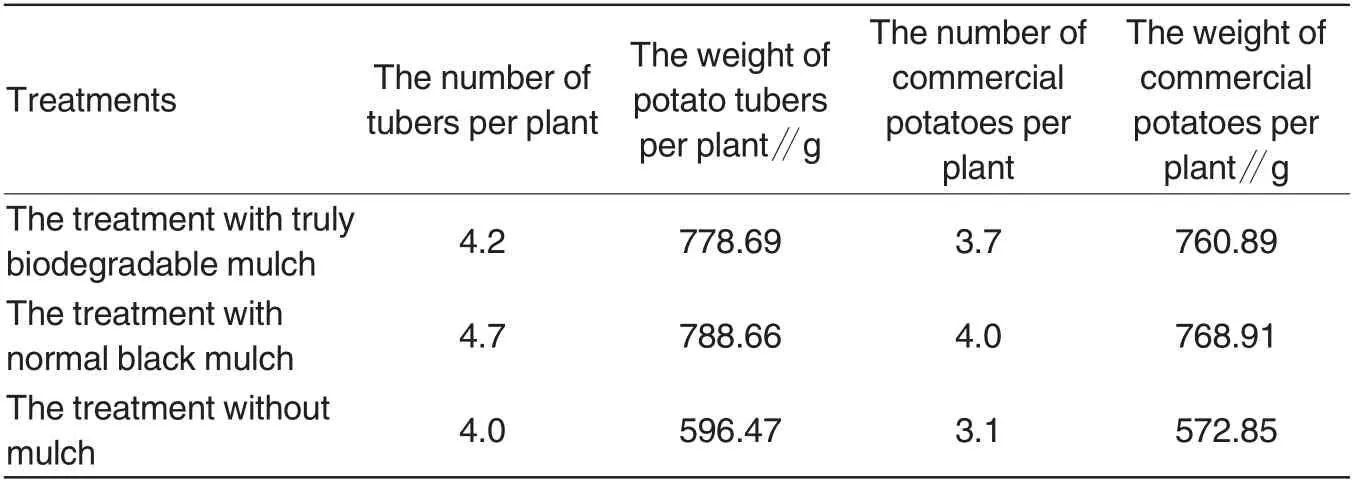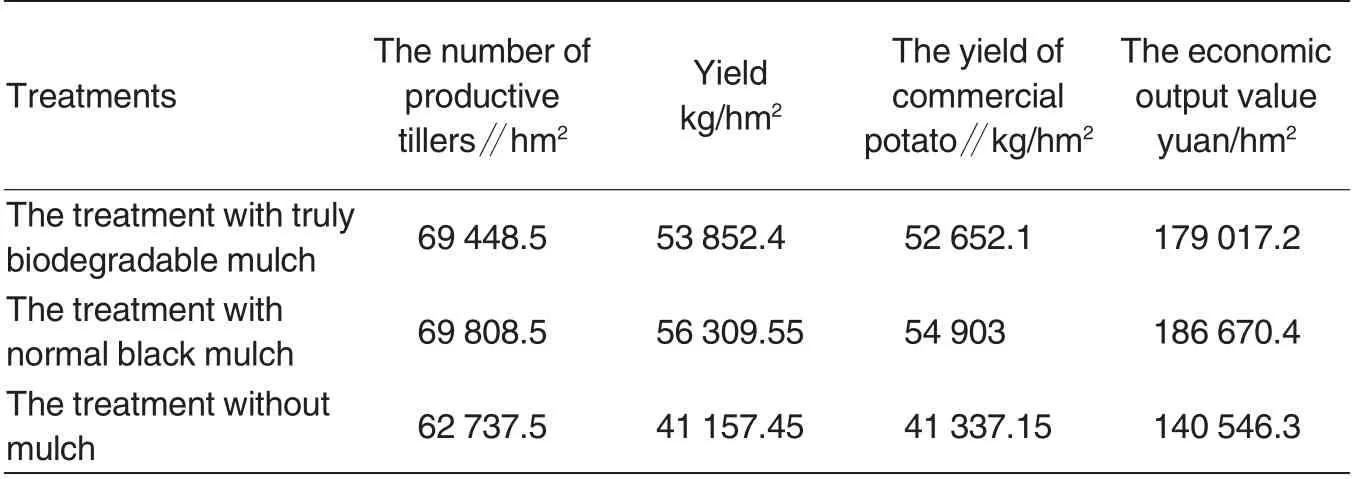The Application Effects of Truly Biodegradable Mulch in Potato Farmlands
2015-12-14XuhuaGAODongXIEYaozhuHUANGHuipingZHANGMingzhouCHEN
Xuhua GAO, Dong XIE, Yaozhu HUANG, Huiping ZHANG, Mingzhou CHEN
Guangzhou Sugarcane Industry Research Institute, Guangzhou 510316, China
The potato is an important food crop, abundant with proteins and starches.Because of great yielding capacity and adaptability, and rich mineral elements, potato is much popular in markets and grown nationwide[1-3]. In the south of China, potatoes are mainly grown in winter and harvested from Spring Festival to Tomb-sweeping Day, when temperatures in the north is not suitable for potato growth. Therefore, potatoes grown in the south meet market demands, accompanying by economic benefits.
Ground mulching cultivation has been widely applied in potato field in the south of China. Black mulch performs well in increasing temperature and maintaining soil moisture, which effectively promotes potato seedling growth[4-5]. Meanwhile, the postponing of growth term lays foundation for creating high yields of potato. Besides,mulching films are light-proof, effectively preventing growth of weeds and reducing hand weeding fees and immature potatoes[6]. However, the use of mulches causes serious environmental problems. For example, with increasing of plastic residues, many problems occur, including soil hardening, weakening permeability and prevention of roots.Currently,the effective way for resolving the issues is to make use of biodegradable mulch.In practice,less attention is paid to application of biodegradable mulch in farmlands. The research explored mulch degradation and the effects of truly biodegradable mulch on agronomic characters and yields of potato,providing references for wide application of truly biodegradable mulch in potato farmlands in the south.
Materials and Methods
Cultivation
The experimental site is located in Pinghai Town, Huidong County,Guangzhou Province. Specifically,seed potatoes were sown on November 13, 2013, and seed potatoes were confined 2 250 kg/hm2.Before sowing,fertilizers were applied, containing chicken manures of 7 500 kg/hm2,special potato fertilizers of 2 250 kg/hm2, and potash magnesium sulphate fertilizers of 150 kg/hm2. Subsequently, furrows were prepared, with soft soil layers of 20 cm, width of 70 cm, and ditches of 110 cm. Besides,the growing density of 75 000 plants/hm2would be appropriate in two rows,with row spacing of 20 cm and planting distance of 22 cm. It is notable that potato eyes should face downward, to promote seed potato growth. On March 22, 2014, potatoes were harvested and agronomic characters were surveyed.
Test materials
The truly biodegradable mulch is produced from Guangzhou Shiweite Economic-technological Development Corp.. The width and thickness of mulches are 70 cm and 0.012 mm,respectively. The black plastic mulches,with width of 70 cm and thickness of 0.012 mm,are produced from Zhongshan Tiande Plastic Factory.The potatoes in the test are local Helan No.15.
Test methods
The research designed three treatments,as follows:the treatment 1 with truly biodegradable mulch, the treatment 2 with normal mulch, and the treatment 3 without mulch. Every treatment had three replications, and the test was conducted in 9 test plots.The area of every test plot was 90 m2,and the plots were surrounded with guarding rows.
The emergence rate of potatoes was surveyed a month after sowing and plant height and stem diameter were measured in peak flowering stage.In harvesting stage,the number of tuber per plant, the weight of tuber,and commercial rate were surveyed.Meanwhile, residual mulches with length of 1 m were collected in harvesting period along ridges and brought to a laboratory to wash, dry and weigh to compute weight-loss ratio,as follows:
The weight-loss ratio(%)=(Weight of original mulch-The weight of residual mulch)/The weight of original mulch×100%.

Table 2 The effects of different treatments on growth traits of potatoes

Table 3 The comparisons of potato yield in different treatments
Results and Analysis
The agronomic characters, such as germination rate and plant heights,were surveyed in squaring stage and peak flowering stage. As shown in Table 1, the germination rates in the treatments 1, 2 and 3 were 94.27%,93.83%and 84.56%,respectively.Furthermore, the germination rate in treatment 1 kept higher compared with treatment 2 and the rates of treatments 1 and 2 improved by 9.71%and 9.27%compared with treatment 3,respectively,which indicated both of truly biodegradable mulch and normal black mulch would accelerate potato germination. Besides, plant height of treatment 1 was the best, followed by treatment 2, and the plant heights of treatments 1 and 2 were 7.81 and 3.91 cm higher compared with treatment 3.
The results showed that both of the number of tubers per plant and the number of commercial potatoes per plant reached the highest in the treatment 2, followed by treatment 1 and treatment 3. What’s more, the weight of potato tubers per plant in treatment 2 was as high as 788.66 g, and in treatment was 778.69 g, which increased by 192.19 and 182.22 g,compared with treatment 3. Besides,the weights of commercial tubers in treatments 1 and 2 grew by 32.83%and 34.23% compared with treatment 3 respectively(Table 2).These indicated that truly biodegradable mulch and normal black mulch would advance tuber growth in varying degrees, increasing commercial rate and tuber weight.
As shown in Table 3, the number of productive tillers in treatments 1 and 2 both exceeded 4 600, and was only 4 182 in treatment 3. The yield of commercial potato was the highest in treatment 2, increasing by 904.39 kg compared with treatment 3, and the yield in treatment 2 was 3 510.14 kg.Because the yield of commercial potato decides output value, treatments 1 and 2 were both of high economic output value which was lower in treatment 3.
After harvesting,residual mulches were collected and brought back to thelaboratory to clean, dry and weight, in order to obtain weight-loss rate. The test results indicated that when truly biodegradable mulch produced from Guangzhou Shiweite Economic-technological Development Corp. was applied, the weight-loss rate reached 58.62%, but the degradation was not shown in treatment 2. These incorporated that truly biodegradable mulch is an environment-friendly material,which is free from environment pollutions.

Table 4 The survey of weight-loss rate in harvesting period with different mulches
Conclusions and Discussions
The truly biodegradable mulch is under influence of temperature, water,ultraviolet intensity, the species and number of soil microorganism. In practice, it should be applied with consideration of local conditions,such as climate, and soil property. Besides, the degradation rate of truly biodegradable mulch tends to be volatile upon the proportions of raw materials. Therefore, it is necessary to select optimal recipe according to crop growth demands,and highlights should be given to degradation at proper time given that crop growth demands can be met.
In the treatment, germination rates in the treatments with truly biodegradable mulch and normal black mulch were both 9.71% and 9.27%higher compared with the treatment without mulches; the number of productive tillers were 10.70% and 11.27%higher;the yields increased by 30.84% and 36.81% higher. In terms of whole growth stage of potato, the use of truly biodegradable mulch in growing potatoes would better conserve water and manure,and preserve temperature, which is conductive to potato germination and yielding.However, mulches usually fall apart in varying degrees in middle or later growth stages of potato.Consequently,weeds would grow under mulches.It is, therefore, recommended that if truly biodegradable mulch is applied to crops with longer growth term, it is necessary to postpone the degradation term to meet crop demands. On the other hand, truly biodegradable mulches would break up in harvesting period of potato, when mechanical properties almost totally lose.Hence,it is field management in later period would not be affected if residual mulches are not collected, for the mulches would totally degrade in a certain period, without environment pollution. As for normal plastic mulches, the materials hardly degrade and have effects on crop growth if not collected timely. In the long run, the use of truly biodegradable mulches would improve crop yield per unit area,without causing environment pollutions, so that it enjoys a promising future in agriculture.
[1]LIU YP (刘玉佩),HUANG XL (黄雪琳),TAN XL (谭小莉),et al.Effect of different mulching treatments on agronomical characters and yield of no-tillage potato(不同覆盖处理对免耕马铃薯农艺性状和产量的影响)[J]. Journal of Henan Agricultural Sciences (河南农业科学),2009(5):113-115.
[2]WANG HQ(王海泉), ZHU JQ(朱继强),WANG JX (汪建学),et al. The effect of microelement and plant growing regulator on the physiological characteristics and yield of potato(微量元素与植物生长调节剂配合对马铃薯生理指标及产量的影响)[J]. Heilongjiang Agricultural Sciences(黑龙江农业科学),2005(5):19-20.
[3]XIE XS(谢小双),BAO SQ(保石全),LIN KH (林克惠). Nutritional character of potato and effect of increasing yield of film mulch (马铃薯的营养特性及地膜增产效应)[J]. Journal of Yunnan Agricultural University (云南农业大学学报),2001,16(1):35-38.
[4]DENG QM (邓其铭), LI YM (李宇苗).High-yielding cultivation technology of potatoes grown in winter in the north of Guangdong Province (粤北冬种马铃薯地膜覆盖高产栽培技术)[J]. Guangdong Agricultural Sciences (广东农业科学),2011(18):8-9.
[5]GAO XH (高旭华), HUANG J (黄健),HUANG YZ (黄瑶珠),et al. Study on herbicidal plastic film for corn in the field(玉米专用除草地膜田间应用效果研究)[J]. Journal of Agriculture (农学学报),2014,3(4):11-13.
[6]MAO YK (毛玉坤), SUN CJ (孙成军),LAN XL (兰小龙),et al.High yield cultivation techniques of potato black plastic film mulching and benefit evaluation in demonstration base(马铃薯黑色地膜覆盖高产栽培技术及示范基地效益评价)[J]. Ningxia Journal of Agriculture and Forestry Science and technology (宁夏农林科技),2013,54(06):61-62.
[7]CHEN MZ(陈明周),YANG YJ(杨友军),HUANG YZ (黄瑶珠), et al. Effect of photodegradable plastics film on increasing sugarcane yield and film degradation in Zhanjiang area(甘蔗光降解地膜在湛江蔗区的增产效应及其降解效果)[J].Sugar Crops of China (中国糖料),2009(2):7-9,13.
猜你喜欢
杂志排行
Agricultural Science & Technology的其它文章
- Effect of Tree Species and Dosage of Rhizomorph Wood on Asexual Propagation of Wild Gastrodia elata.Bl.f.glauca S.Chow in Ganzi
- Effects of Different Application Times of Tillering Fertilizer on Grain Yield and Population Development of Double-cropping Rice Transplanted by Machine
- Biological Characteristics and Pathogenicities of Shewanella algae and Shewanella abalone from Babylonia
- Research on Physiological Characteristics of Tall Fescue under Nitrogen Stress
- Cloning and Characterization of Phytochrome A Gene FaPHYA from Tall Fescue
- Changes in Physiological Indexes of SPDS Transgenic Potato Plants under Low Temperature Stress
